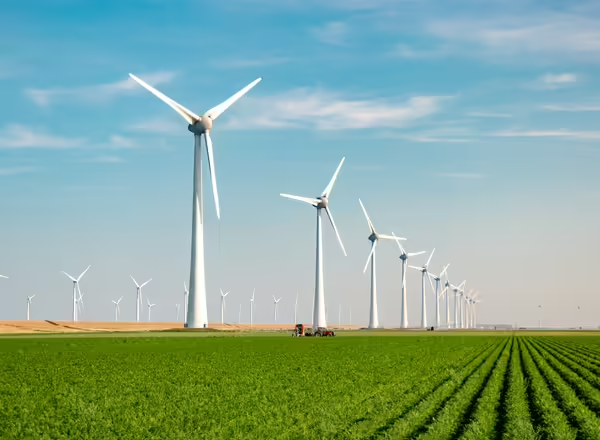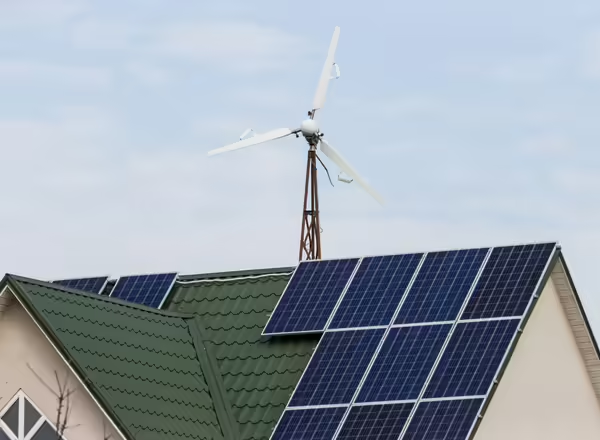Title
Wind energy in Illinois
Illinois is among the top 5 U.S states for installed wind capacity, with almost 13% of our energy being generated by wind. The majority of wind farms in Illinois are located in the central and northern regions, where wind is abundant.
One of the largest wind farms in Illinois is the Twin Groves Farm, constructed in 2008 in McLean County. There, 240 wind turbines generate enough power for 120,000 homes. Despite its size, the wind turbines only take up 1% of the 22,000 acres of the site. The property taxes from the farm provide $300,000 a year to a nearby school district.
How does wind energy work?
Wind is the most common form of renewable energy in Illinois. Wind energy starts with the sun. The sun heats Earth’s surface unevenly due to varying terrain, oceans, and atmospheric conditions. This uneven heating causes air to move, creating wind. Warm air rushes into its place, setting air in motion. This is why you often get strong winds when there’s a sudden temperature change, like a warm day followed by a cold front.
Wind turbines generate power by converting wind into electricity. When the wind blows, it turns the blades of the turbine which spins a generator to produce power.
There are three types of wind energy systems

The most common systems. These are what you see in open plains and hilltops where the wind is strong and consistent. They can power anything from small communities to large regions.

These turbines are built in bodies of water, typically in oceans or large lakes. These are more expensive to build and maintain. There aren’t currently any offshore wind projects in Illinois, but there are proposals to build in Lake Michigan.

These are smaller wind turbines that can be used to generate electricity for a home, farm, or business. These are more common in rural settings.
Title
Parts of a wind turbine
There are four main components to a wind turbine:
- Blades: Shaped like an airplane wing to catch the wind, most turbines have three blades, which are made of fiberglass
- Rotor: This is the hub that the blades are attached to. It spins when the blades move and transfers that spinning motion into the rest of the turbine.
- Nacelle: The large box at the top of the tower, behind the rotor. It contains three working parts:
- The gearbox increases the speed of rotation
- A generator converts motion into electricity
- Brakes and control systems for turbine safety
- Tower: The support structure, usually made of steel contains power cables that connect to a transformer at ground level.
Image from ResearchGate.
Wind turbine sizes are growing. Larger turbines generate energy at a lower cost. A study by the Lawrence Berkeley National Laboratory found that newer wind turbines will be nearly two-thirds taller than those built a decade ago, which decreases the number of turbines needed by more than half. Average sound levels will drop by 18% for neighboring homes in the future. Even though these turbines will be larger, they will still be constructed at a safe distance from neighboring homes due to setback requirements.
How do wind farms affect communities?
For many communities, wind turbines are a new sight and an unfamiliar addition to the landscape. It is normal to have questions about how they might fit into your local area.
Common Wind Turbine Questions
Will turbines impact my health?
One of the most common health concerns with wind turbines are the sound and vibrations. Wind turbines make noise, but studies by medical and acoustic experts have found:
- There’s no evidence that wind turbine sound, whether loud or very low, causes health problems.
- The vibrations from turbines are too small to be felt or cause harm.
- The level of sound is similar to everyday background noise.
- Wind farms must follow local sound and distance rules to make sure they’re placed safely.
Do wind turbines harm birds?
Wind turbines can affect birds and bats, but they’re not a leading cause of bird deaths. For example:
- A study estimated 140,000 to 328,000 bird deaths per year from wind turbines.
- In comparison, power lines kill an estimated 12 million to 64 million birds in the U.S every year.
Researchers are developing ways to reduce these impacts, such as painting one turbine blade black, which one study found could cut bird collisions by over 70%.
The Federal Endangered Species Act also protects endangered species and their habitats. This limits the ability to develop in these areas and protects certain wildlife from being affected by renewable energy projects.
Will wind turbines lower my property value?
Research shows that any changes in home value are usually temporary and depend on how close the home is to a wind project.
A study of 500,000 home sales within five miles of U.S wind projects across 34 states found:
- Homes within 1 mile saw an average price drop of about 11%, mostly during construction.
- Homes 3–5 miles away were much less affected.
- Prices tended to return to normal levels about 3–5 years after the project started operations.
Keep in mind, this study didn’t measure other local benefits like job creation or tax revenue, which could also influence home values. It also didn’t compare property values between homes near wind projects to those without.
What about the flashing red lights at night?
Those blinking lights on wind turbines are there for aircraft safety, as required by the Federal Aviation Administration. But new technology is helping reduce the impact:
- Radar systems can now turn the lights on only when an aircraft is nearby
- In some areas, local zoning laws require these systems to reduce light pollution
If you're concerned, it’s worth asking your local officials or project developers if this technology will be used.
What about shadow flicker?
The shadow flicker effect is when the sun shines through the rotating blades of a wind turbine and casts a moving shadow. The concern stems from how this feels from the inside of a building, where there could be a repeating flicker of alternating light and dark through the windows.
However, a specific angle of the sun is needed to cause this effect. It is rare and only happens in limited locations and for a few hours. It poses no concern to human health as the turbines don’t move fast enough to trigger sensitivities to flashing lights or contracting light and dark patterns.
Computer models have been developed that can help predict shadow flicker, which can help projects to mitigate the potential for this in the site selection and turbine layout process. Additionally, many wind energy ordinances require a minimum setback distance for wind turbines. This can be used to further prevent shadow flicker.
What happens when the land lease ends?
Wind turbines typically last around 20 to 30 years, especially the foundation and the tower. Other parts, like the blades, gearboxes, or generators, may wear out sooner and can often be replaced or upgraded over time.
When a wind project reaches the end of its life, there are two main paths forward:
- Repowering: Upgrading the existing site with newer, more efficient turbine technology. This can extend the project’s life and increase energy output.
- Decommissioning: Removing the turbines and restoring the land, often as outlined in the original lease agreement.
Each project is unique, and landowners should review their lease terms and discuss future plans with the developer well in advance.
Explore more about Decommissioning and Repowering.